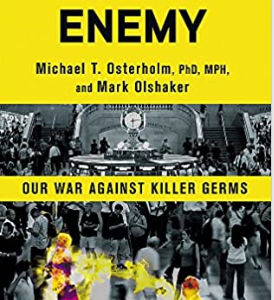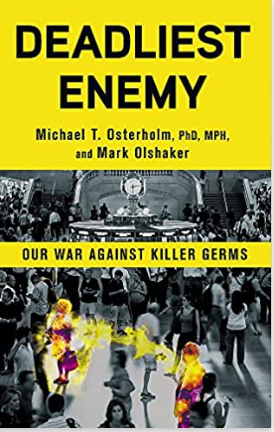
War on killer germs

A pandemic on the scale of the 1918 flu that killed over a hundred million people would be deadlier today, despite a century of medical advances, as every new development from exploding human and animal populations to trade and travel intensifies our susceptibility to a devastating epidemic.
Leading epidemiologist and professor at the University of Minnesota, Michael Osterholm’s book demands a rethink for the Deadliest Enemy Our War against killer Germs.
In today’s world, it’s easier than ever to move people, animals and materials around the planet, but the same advances that make modern infrastructure so efficient have made epidemics and even pandemics nearly inevitable. As Outbreaks of COVID-19, Ebola, Mers and Zika have demonstrated, we are woefully underprepared to deal with the fallout. So what can- and must- we do in order to protect ourselves fro m mankind’s deadliest enemy.
Drawing on the latest medical science, case studies, policy research and hard earned epidemiological lessons, Deadliest Enemy explores the resources and programs we need to develop if we are to keep ourselves safe from infectious disease. The authors remind us that we wake up to a reality in which many antibiotics no longer cure, bioterror is a certainty, and the treat of a disastrous influenza or coronavirus pandemic loons ever larger.
Osterholm and his co-author Mark Olshaker, has pictured a fictional pandemic scenario “ If a factory in China suddenly can’t function because of 30 or 40 per cent of its work force is sick, we don’t have a stockpile of its goods … to tide us over until the factory reopens”.
Similar outbreaks “in enough places at the same time” would render factories unable to source parts and supplies, sparking a domino effect in which world trade suffers and economies start to falter.”
Osterholm had spun a dystopian vision in which nations battle each other for N95 masks, doctors rations ventilators and unemployment hit levels that make the great depression look like a pot hole.
Deadliest enemy was first published in 2017, now an updated version is being released in the UK. This is real life pandemic is just the right time to reappear, Osterholm’s ideas, even if mistakenly fictionalised the culprit as Influenza.
In 2001, he set up the center for Infectious Diseases Research and Policy in Minneapolis and has advised US health secretaries and the centres for disease control and prevention on issues ranging from HV/Aids to bioterrorism.
Deadliest Enemy starts by defining the purpose of epidemiology: not preventing mortality, which is impossible, bad deaths are replaced by good deaths. A 90-year-old man with limited mental and physical impairment expiring in his sleep is a good death, A six-year-old child dying of a diarrheal disease is a bad death.”
There are accounts of his involvement in the early days of the HIV?Aids crisis – where Anthony Facuci, Donald Trump’s COVID-19 adviser, and friend of Osterholm, made his reputation – and toxic shock syndrome in which a spate of tragically young female deaths was eventually traced back a to new tampon material that fuelled growth of leathal bacteria.
Osterholm argues , we must identify diseases with the potential to disrupt the world order so that we can make rational decisions about where to put our resources, where to direct our policy, and where to direct our fear.
During the 2015 Zika epidemic , a congressman told him that “ If we could show that each mosquito was actually a drone controlled by Isis, we would get all the Zika funding we wanted”.
Pathogens – disease causing micro-oranisms – of pandemic potential which include Influenza plus the various nasties implicated in antimicrobial resistance, a killer that threatens the foundations of modern medicine.
Pathogens that cause huge regional outbreaks such as Mers, Sars, Ebola, Zika and other mosquito-borne diseases.
Pathogens such as anthrax or smallpox released either intentionally in acts of bioterrorism or accidently through “gain of function” studies which involve labs legitimately thinkering with viruses to investigate severity.
Finally pathogens that cause endemic diseases such malaria and tuberculosis mostly in the global south.
Vaccines, are one obvious solution according to Osterholm, that nobody, crazily, has ultimate responsibility for financing. When the Sars epidemic ended in 2003, the pharma companies that had been pressured to spend millions chasing a vaccine ended up with no governments wanting to place orders. A Sars vaccine might well have left us better placed to face the current pandemic.
Osterholm argues , there should be an equivalent of Nato for health.
In the apparent WHO’s impotence during the pandemic, the UK parliament’s foreign affairs select committee last week advocated a “G20 for public health”.
This book will change our thinking on natural threats and will help to shape the essential post coronavirus conversation.
Deadliest Enemy: Our War Against Killer germs by Michael Osterholm and Mark Olshaker, John Murray £14.99/ Little Brown $28, 368 pages.
